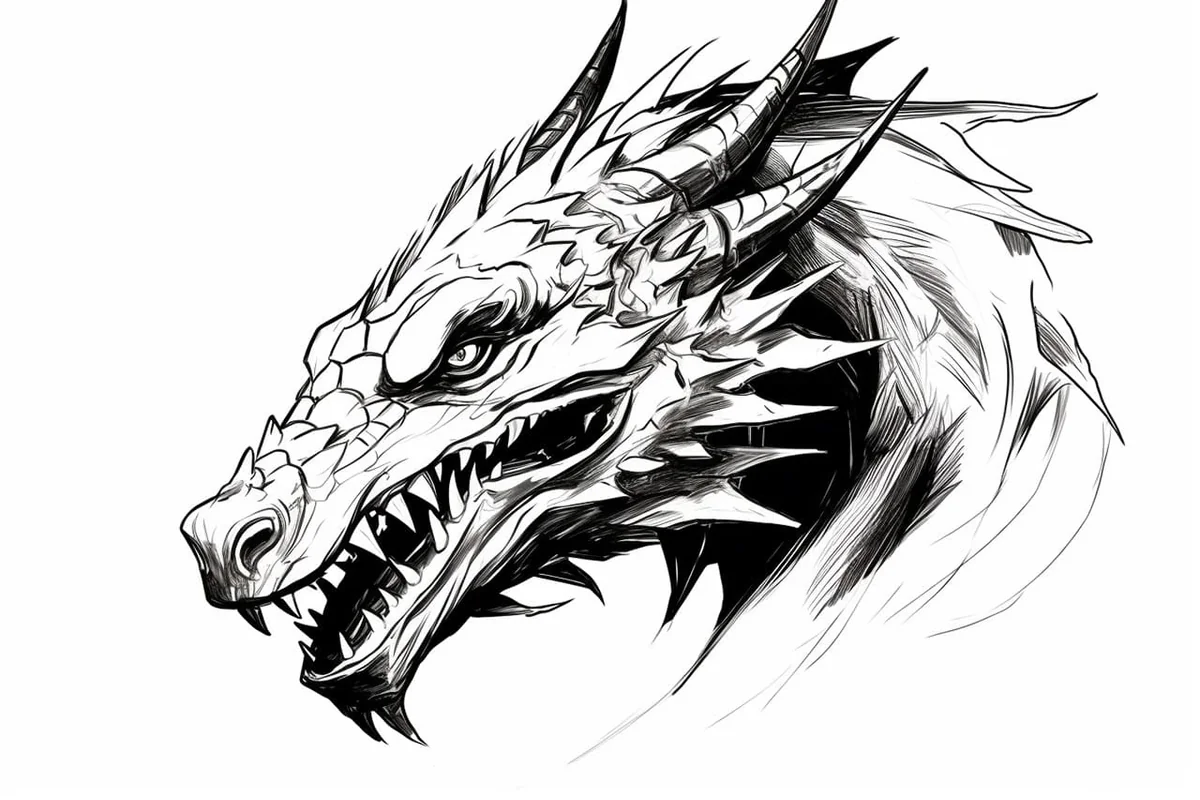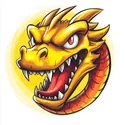How to Draw a Dragon Head
Learn how to draw with this step-by-step tutorial.

Materials You'll Need
- Drawing paper
- Pencil (HB or 2B)
- Eraser
- Blending stump

Welcome to this engaging step-by-step tutorial on how to draw a dragon head! Dragons, with their mythical allure and magnificent presence, have captured the imagination of people for centuries. From ancient legends to modern fantasy tales, these awe-inspiring creatures continue to be a symbol of power, wisdom, and mystery across various cultures. Drawing a dragon head can enhance your artistic skills, providing endless inspiration for fantasy art, storytelling, and character design.
In this comprehensive guide, you'll explore the techniques and strategies needed to create a stunning dragon head drawing. Whether you're a beginner or an experienced artist looking to expand your repertoire, this tutorial will break down the process into manageable steps, making it accessible and enjoyable for everyone. So, gather your sketchbook, sharpen your pencils, and prepare for an exciting artistic journey as we bring your dragon head to life!
Let's dive right in and unleash your creativity. Are you ready to embark on this artistic adventure? Together, we'll explore the intricacies of form, shape, and detail that will elevate your drawing skills. By the end of this tutorial, you'll not only have a fantastic dragon head drawing but also the confidence to tackle more complex designs. Let's get started!
Materials Required
Before we dive into the steps, let's gather the materials you will need for this drawing:
-
Drawing paper: Choose a medium-weight paper that is suitable for sketching. A size of at least 9x12 inches is recommended.
-
Pencils: Have a range of graphite pencils available, from 2H (lightest) to 6B (darkest). You can also use mechanical pencils with different lead weights.
-
Eraser: A kneaded eraser is ideal for this drawing, as it can be shaped to remove small details and texture.
-
Blending tool: You can use a blending stump or a tortillon to smudge and blend graphite for shading.
-
Reference images: Find a few reference images of dragon heads to inspire your drawing. These can be found in books or online.
Now that we have our materials ready, let's dive into the step-by-step process of drawing a dragon head!
How to Draw a Dragon Head Step-by-Step
Step 1: Basic Shape
Start by lightly sketching the basic shape of the dragon head. Use simple geometric shapes, such as circles and rectangles, to outline the head, snout, and jawline. Don't worry about details at this stage; focus on getting the proportions and overall shape right.
Step 2: Eyes and Horns
Next, draw the eyes and horns of the dragon. Place the eyes in the upper part of the head, slightly tilted towards each other. Dragons often have large, expressive eyes, so draw them accordingly. Add the horns on top of the head, curving them outward or upward for a more menacing look.
Step 3: Nose and Snout
Now, let's work on the dragon's nose and snout. Extend the basic shape of the head into a snout, tapering it towards the end. Add details to the nostrils and draw the line of the mouth, giving it a slight curve to imply a fierce expression. Pay attention to the placement and symmetry of these features.
Step 4: Teeth and Tongue
Dragons are known for their sharp teeth, so let's add them now. Draw a row of teeth inside the mouth, making them pointy and uneven to add realism. Add a snake-like tongue at the bottom of the snout, curling it slightly for added effect.
Step 5: Scales and Texture
Tip: As you work through the steps of drawing a dragon head, consider taking breaks to step back and evaluate your work from a distance; this can help you better assess proportions and overall balance. Additionally, don't hesitate to experiment with different styles and features, such as varying the shape of the horns or the expression of the eyes, to give your dragon a unique character that reflects its personality.
One of the defining features of a dragon is its scales. Start adding scales to the dragon's head, working from the top and moving towards the bottom. Use curved lines to create the diamond-shaped scales, making them smaller as you move towards the snout. Add texture to the horns, snout, and other areas using short, curved lines.

Step 6: Shading and Highlights
To give your dragon head drawing depth and dimension, let's add shading and highlights. Determine the light source in your drawing and shade the areas that would be in shadow. Use hatching or cross-hatching techniques to create depth and form. Leave some areas lighter to represent highlights, such as the edges of the scales or the shiny parts of the horns.
Step 7: Final Details
Now that your dragon head is taking shape, it's time to add the final details. Refine the shapes of the eyes, horns, and teeth. Add any additional texture or details that you feel will enhance the overall appearance of the dragon. Take your time with this step and make any necessary adjustments to ensure your drawing looks its best.
Challenge: Imagine your dragon head emerging from a swirling cloud of mist, surrounded by flickering flames or perched atop a craggy mountain peak! For this challenge, try drawing your dragon head in an unexpected context—maybe it's emerging from a hidden cave or soaring majestically through a stormy sky. Focus on adding dynamic elements like wind-swept scales, glowing eyes, and dramatic lighting to convey the creature's fierce energy. Don't hesitate to experiment with different angles and expressions to bring out its personality. By stepping out of your comfort zone and incorporating these additional elements, you'll not only enhance your drawing skills but also create a compelling scene that tells a story!
Conclusion
Congratulations on completing your dragon head drawing! By following these step-by-step instructions, you have learned the techniques required to create a visually striking dragon head. Remember, practice is key to improving your drawing skills, so don't be discouraged if your first attempt isn't perfect. Keep experimenting, exploring, and applying these techniques to create your own unique dragon drawings.
Now that you have mastered the art of drawing a dragon head, the possibilities are endless. Add this skill to your artistic repertoire and let your imagination soar. Happy drawing!
Gallery of Dragon Head Drawings




Frequently Asked Questions about Dragon Heads (and the dragons they are attached to)
What is the significance of dragon heads in Chinese culture?
Can dragon heads be found in other cultures besides Chinese?
Are dragon heads only found in mythology, or do they have practical applications?
How are dragon heads depicted in art and literature?
Do dragon heads hold any significance in feng shui practices?
Fun Facts About Dragon Heads
-
No two dragon heads are alike – Across cultures, dragon heads range from sleek and serpentine to bulky and armored, often reflecting a dragon's elemental powers, personality, or mythology. Artists often explore a wide variety of head shapes and features to bring dragons to life.
-
Eastern vs. Western styles – Eastern dragons tend to have flowing whiskers, lion-like faces, and a more benevolent look, while Western dragons feature horned, reptilian heads, often snarling and battle-scarred, representing chaos and fire.
-
Eyes that tell stories – A dragon's eyes can radiate wisdom, danger, or magic. They're a favorite focal point in folklore and fantasy art, as seen in discussions of the mystical "dragon's eye" and in detailed art tutorials that teach how to capture their expressive power.
-
Teeth for more than biting – Dragon teeth in mythology are often exaggerated, ranging from razor-sharp to curiously neat. In ancient tales, planting dragon's teeth could grow an army, a nod to their magical symbolism.
-
Some dragons have multiple heads – From the Greek Hydra to the Balkan Kucedra, multi-headed dragons are legendary creatures. Each head might have a distinct voice or elemental power, creating a terrifying (or hilarious) ensemble.
-
Horns, crests, and frills, oh my! – Dragon heads often feature ornamental crests, curved horns, and spiky frills—design elements that show rank, magical energy, or just artistic flair. These features help distinguish breeds and personalities in storytelling and media.
-
Not always scary! – While many dragons are built to terrify, others—like **Toothless from How to Train Your Dragon—are charming, noble, or downright adorable. Children's books are full of friendly dragons that guide, protect, and play.
Suggested Scenes and Settings for Dragon Head Drawings
-
Crowned Guardian – A close-up of a regal dragon head with jeweled horns and a golden crown, guarding a mountain pass or ancient vault.
-
Elemental Roar – A roaring dragon head emerging from a storm, volcano, ocean wave, or snowy blizzard—each element shaping its features and expression.
-
Hatchling Stare – A newly hatched baby dragon pokes its tiny head out of a cracked egg, eyes wide with curiosity.
-
Wise Old Wyrm – An ancient dragon head peeking out of a cave or library, covered in moss and runes, with an owl perched on one of its horns.
-
Battle-Scarred Beast – A dragon head bearing deep scars, broken horns, or missing teeth, staring fiercely ahead as smoke rises from its nostrils.
-
Floral Fusion – A gentle dragon head adorned with flowers, vines, or butterflies—perfect for blending fantasy and nature.
-
Lantern Glow – A glowing dragon head carved into a floating lantern, used by villagers to ward off spirits or summon good luck.
-
Celestial Serpent – A sleek, celestial dragon head flying through stars and nebulae, its features outlined by constellations.
-
Mirror Duel – Two dragon heads, perfectly symmetrical but different in design—light vs. dark, fire vs. ice—locked in a magical standoff.
-
Totem of Power – A carved dragon head atop a towering stone pillar, surrounded by swirling magical energy or ancient symbols.